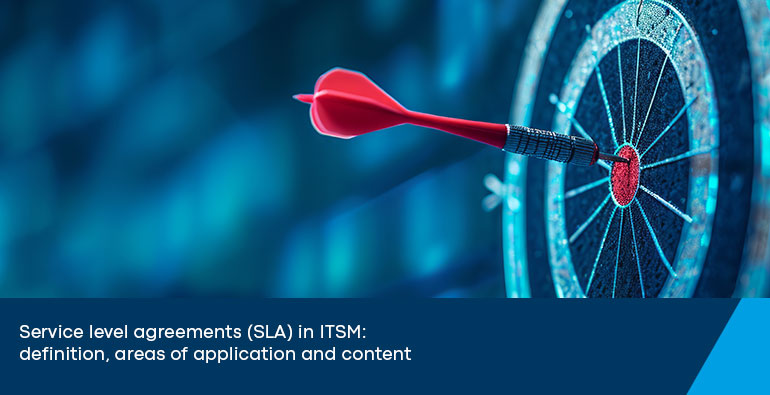Service level agreements (SLA) in ITSM: definition, areas of application and content

Definition of SLA: What is a service level agreement?
Service level agreement means contractually defined (and measurable) service quality. It is in other words an agreement between a service provider (service provider/provider) and a service consumer (customer) on the quality and scope of services.
The aim of SLAs is to define the subject matter of the contract (in this case the service) and its execution in advance using measurable parameters. At the same time, communication about the service should lead to a sustainable improvement in services and increase user and customer satisfaction.
The term “levels” is used because a service level agreement can have different characteristics or gradations. Customers (i.e. also users or service consumers) with a “lower” level may have to wait longer for support than those who pay for a higher level. These levels can be fixed or individually negotiated. As a rule, the consequences of deviations from these contractual agreements are set out in writing and are binding and transparent for all parties within the SLA.
Areas of application of service level agreements
Service level agreements originated in the field of IT services. SLAs were later extended to other service areas. These primarily include telecommunications, external call centers, logistics, payment systems, e-commerce solutions, personnel services and marketing agencies as well as customer support. SLAs are agreed wherever a company is dependent on the service of another and pays for it; internal services are also possible. SLAs ensure greater transparency in the exact service obligations between service provider and service consumer. SLAs are widely used in the field of IT service management; for example, ITIL®—the best practice catalog for ITSM—provides practical recommendations for efficient service level management with high customer satisfaction.
What components does a SLA contain?
First, the service provider creates a catalog of all the services it offers. This basic catalog can then be enriched for a customer with individual customer requirements or modified in its characteristics. The subsequent contract is created on this basis. It usually includes the following points:
- Details of the contractual partners
- The jointly pursued goals (keyword: “value co-creation”)
- List and definition of the services to be offered
- List and definition of the services that are explicitly not provided
- Level or designation of the level/service packages (bronze, silver, gold, medium, premium, etc.)
- Response time for inquiries or incidents
- Maximum time until rectification
- Effect of queries on response times
- Service times/availability of customer service (e.g. 8 a.m. to 5 p.m. or 24/7)
- Procedure for resolution, if relevant for the customer
- Measured values that must be adhered to or achieved again after an incident
- Costs for the services (fixed costs and variable components)
- Bonuses if targets are exceeded (if accepted in advance by both parties)
- Consequences and penalties for non-compliance
- Security measures for data and information protection
- Contract term and scope of the SLA
- Information on the possibility of amending and terminating the contract
A report should be prepared at regular intervals on the extent to which the service agreements have been fulfilled. Internally, this helps with service improvement. Externally, you can use the figures to prove your quality to the customer. The preparation of these reports should also be included in the contract.
The ITIL® best practice framework supports you in efficient and customer-oriented service management.
Advantages for service providers and consumers through service level agreements
Service level agreements bring transparency to complex service business processes and protect both sides from misunderstandings. The client may expect an all-round service, while the provider strives for or is able to provide the lowest possible level of support. SLAs create (also legal) clarity here.
The following applies to both sides: Iterative feedback on the services provided creates valuable optimization potential. The exchange and change of perspective also serve to further develop the SLAs themselves and adapt them to the satisfaction of both parties.
Benefits of SLAs for the service provider
Service level agreements help to prioritize services. This allows the service provider to focus on high-revenue customers, which leads to greater customer satisfaction and loyalty. Sensible prioritization also facilitates resource planning. The intention of improving services through feedback obtained as part of SLAs is also key.
At the same time, SLAs result in cost benefits, as services are only provided to the contractually agreed extent. Only what the customer pays for is provided. Last but not least, a (higher) service level can be seen as upselling. However, economic aspects should not be the main focus. The primary focus is on sustainable service improvement and intensifying the customer relationship.
Benefits of SLAs for the service consumer
For the consumer, a service level agreement guarantees reliability and ensures the quality of a purchased service. After all, there is no binding service quality without an SLA. Thanks to a predictable service quality, customers (and users) can also plan better, especially if the service consumers themselves are service providers who have to supply customers with goods or services. SLAs also make it possible to compare providers objectively.
If a service provider offers several SLA levels to choose from, this also supports your scalability.
The OMNITRACKER ITSM Center offers all the central functions required to efficiently integrate SLAs. It also includes other classic ticketing features in accordance with ITIL. You are welcome to book a personal tour of our ITSM demo room, which you can then test free of charge for 30 days.
How flexible ITSM solutions support service level management
SLA functions are integrated into modern service management solutions. For example, the customer’s master data is already integrated during ticket creation and escalation timers are started for any response times. Classic ticketing functions such as linking tickets via parent-child relationships and automatic prioritization and assignment to the appropriate employee as well as the use of artificial intelligence increase your efficiency and make it easier for you to reliably meet your SLA time targets. At the same time, SLA information and all previous communication can be called up directly in the ticket. SLA timers can also be controlled via the statuses within the ticket, for example if a query is sent to the customer via the “Waiting” status, which then temporarily stops the SLA times.
Business Intelligence functions also make it easier for you to keep an eye on your high-priority services and the current workload of your service desk.
Last but not least, all SLA parameters can be controlled in the ITSM software and viewed by everyone involved in the process. When formulating SLA contracts, however, make sure that they are clearly measurable and leave no room for subjective evaluation.
Newsletter sign-up
Would you like to stay up to date on digital service management, GRC and automation? In our newsletter, we inform you about relevant blog posts and professional articles. We also regularly send you information about events, DACH-wide trade fairs and our free live sessions in the areas of service management, process automation, GRC and analytics with business intelligence. We will inform you about new features of the OMNITRACKER business process platform.
